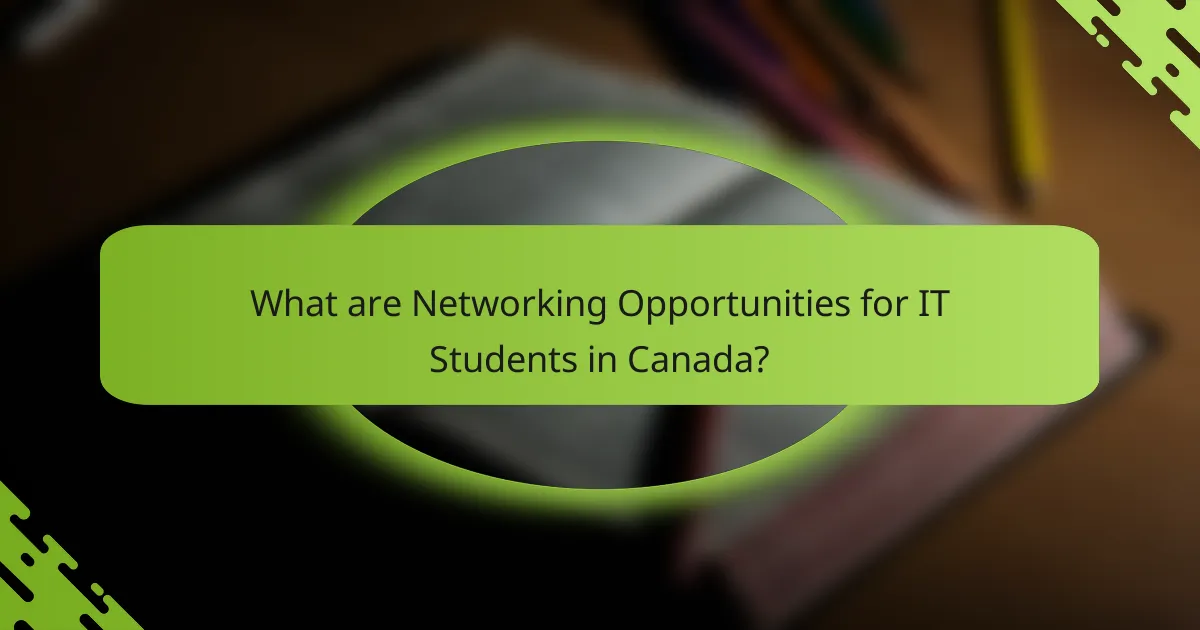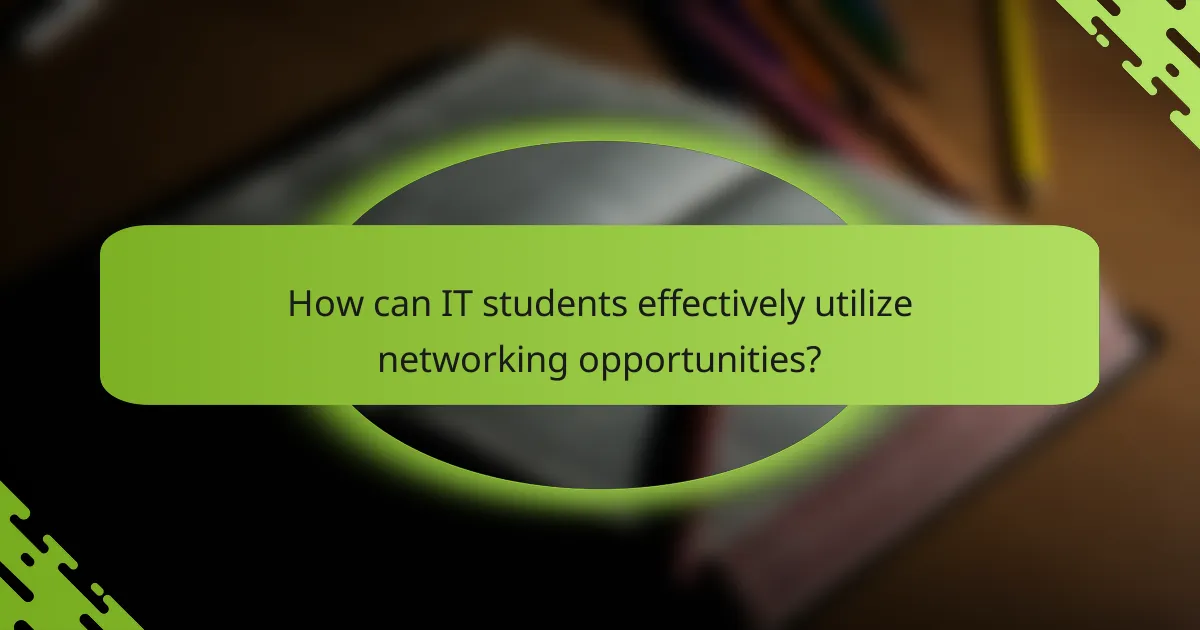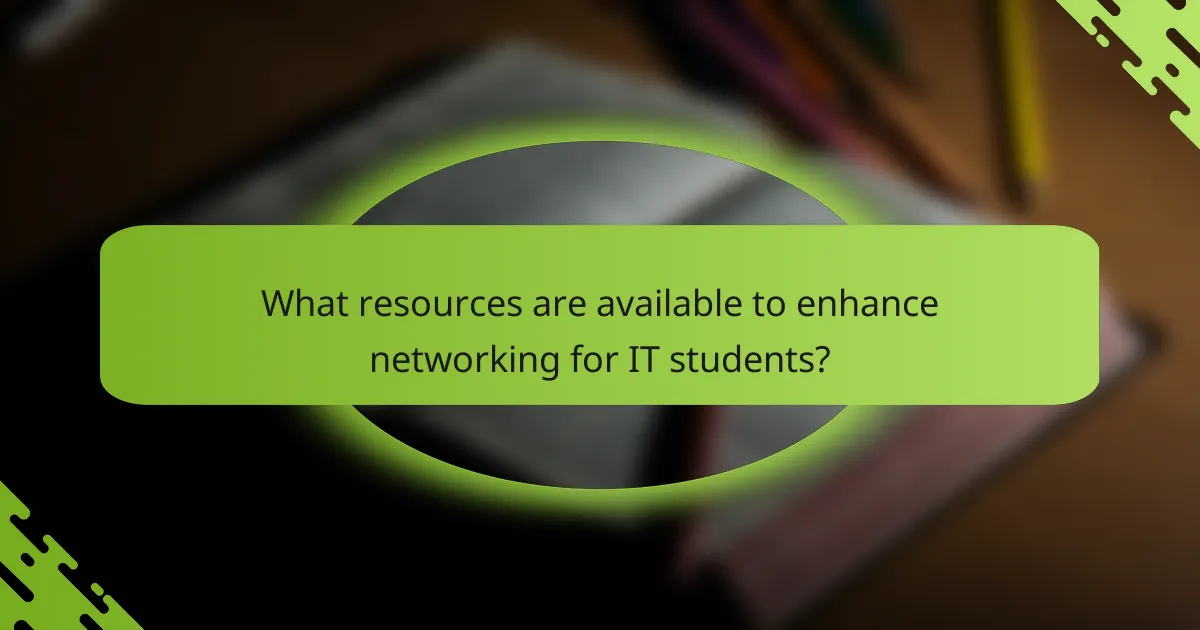Networking opportunities for IT students in Canada encompass industry conferences, tech meetups, university career fairs, and mentorship programs. Key events, such as the Canadian Conference on Computer and Software Engineering, facilitate connections between students and industry professionals. Organizations like the Canadian Information Processing Society and the Association for Computing Machinery provide essential networking events and workshops. Engaging in these opportunities enhances employability, with surveys indicating that a significant percentage of students secure jobs through networking. Resources like online platforms, local meetups, and mentorship initiatives further support IT students in building valuable professional relationships and advancing their careers.

What are Networking Opportunities for IT Students in Canada?
Networking opportunities for IT students in Canada include industry conferences, tech meetups, and university career fairs. Events like the Canadian Conference on Computer and Software Engineering provide platforms for students to connect with professionals. Organizations such as the Canadian Information Processing Society offer networking events and workshops. Mentorship programs like Tech Girls Canada pair students with industry mentors. These opportunities facilitate knowledge sharing and career advancement. According to a survey by the Canadian Council of Technicians and Technologists, 70% of students found jobs through networking. Networking enhances employability and professional growth for IT students.
Why is networking important for IT students?
Networking is important for IT students because it connects them with industry professionals and peers. This connection can lead to job opportunities and internships. Networking helps students gain insights into industry trends and best practices. It also fosters collaboration on projects and ideas. Furthermore, building a professional network enhances visibility in the job market. According to a survey by the National Association of Colleges and Employers, 85% of jobs are filled through networking. Thus, effective networking is crucial for career advancement in IT.
What skills can be developed through networking?
Networking can help develop several key skills. These include communication skills, which improve through interactions with diverse professionals. Networking fosters relationship-building skills, essential for creating lasting connections. It enhances interpersonal skills by encouraging collaboration and teamwork. Additionally, networking aids in developing negotiation skills through discussions and exchanges. Problem-solving skills are also refined as individuals navigate challenges in networking situations. Finally, networking can boost confidence, as engaging with peers and mentors provides valuable feedback and support.
How does networking impact career opportunities?
Networking significantly enhances career opportunities. It allows individuals to build relationships with industry professionals. These connections can lead to job referrals and insider information about openings. Research indicates that 70% of jobs are found through networking. Networking also provides access to mentorship, which can guide career development. Engaging in networking events can increase visibility in the job market. Moreover, networking helps individuals stay informed about industry trends and innovations. This knowledge can make candidates more competitive in their field.
What types of networking opportunities are available?
Networking opportunities for IT students include industry conferences, workshops, and meetups. These events facilitate connections with professionals and peers. Organizations such as tech clubs and student associations also provide networking platforms. Mentorship programs connect students with experienced industry professionals. Online networking through platforms like LinkedIn offers additional opportunities for engagement. Career fairs allow students to interact directly with potential employers. Networking events hosted by universities create a community for sharing knowledge. Each of these opportunities enhances career prospects and industry understanding.
What are the main events for IT students in Canada?
The main events for IT students in Canada include conferences, hackathons, and networking meetups. Events like the Canadian Undergraduate Technology Conference (CUTC) provide a platform for students to learn and network. Hackathons such as Hack the North and MLH Localhost encourage practical skills and collaboration. Networking meetups organized by tech organizations like Techfest connect students with industry professionals. Additionally, events hosted by universities often feature guest speakers and workshops. These events foster community and enhance career prospects for IT students.
How do organizations support networking for IT students?
Organizations support networking for IT students by hosting events, providing mentorship programs, and facilitating industry connections. These events often include workshops, seminars, and tech meetups, allowing students to engage with professionals. Mentorship programs pair students with experienced industry members for guidance and networking opportunities. Organizations also collaborate with companies to create internships and job fairs, enhancing student exposure to potential employers. Networking platforms and online communities are created to foster ongoing connections among students and professionals. This structured support enhances career prospects and industry readiness for IT students.
What mentorship programs exist for IT students?
Mentorship programs for IT students include TechWomen, Code2040, and the ACM-W Mentorship Program. TechWomen connects women in tech with mentors from leading companies. Code2040 supports Black and Latinx students in tech through mentorship and internships. The ACM-W Mentorship Program offers guidance and resources for women in computing. These programs provide networking opportunities and professional development. They also enhance skills and career prospects for participants. According to a 2020 study, mentorship significantly increases job placement rates for IT graduates.

How can IT students effectively utilize networking opportunities?
IT students can effectively utilize networking opportunities by actively participating in industry events. Engaging in conferences, workshops, and seminars allows them to meet professionals. They should also join relevant organizations and student groups. Membership in these groups provides access to exclusive events and resources. Building relationships with peers and mentors is crucial for long-term success. Networking can lead to internships and job offers. According to a survey by LinkedIn, 85% of jobs are filled through networking. This statistic underscores the importance of making connections in the IT field.
What strategies should IT students employ during networking events?
IT students should employ several strategies during networking events. First, they should prepare an elevator pitch. This pitch should clearly articulate their skills and interests. Next, they should research attendees and companies beforehand. Understanding the background of professionals can lead to meaningful conversations. Additionally, students should actively engage in discussions. Asking questions shows interest and encourages connection.
Students should also follow up after the event. Sending a thank-you email can reinforce the connection made. Utilizing social media platforms like LinkedIn is crucial. Connecting online helps maintain relationships with industry professionals. Lastly, students should attend events regularly. Consistency in networking builds a stronger professional network over time.
How can students prepare for networking events?
Students can prepare for networking events by researching attendees and companies. They should identify key individuals they want to connect with. Preparing an elevator pitch is essential. This pitch should succinctly explain their background and goals. Practicing active listening skills is also important. Students should be ready to engage in meaningful conversations. Dressing appropriately for the event can create a positive first impression. Finally, following up with contacts after the event reinforces connections. These preparation steps enhance the likelihood of successful networking outcomes.
What follow-up actions should students take after networking?
Students should send thank-you emails to their networking contacts. This action expresses gratitude and reinforces connections. Emails should be personalized and mention specific topics discussed. Students should connect on professional platforms like LinkedIn. This helps maintain ongoing relationships and visibility. Following up with additional questions shows continued interest. Sharing relevant articles or resources can add value to the relationship. Setting up informational interviews can lead to deeper insights. These follow-up actions enhance networking effectiveness and create future opportunities.
What are the challenges faced by IT students in networking?
IT students face several challenges in networking. Limited practical experience can hinder their ability to apply theoretical knowledge. Many students struggle with communication skills, making it difficult to engage with professionals. Time constraints from academic commitments often limit networking opportunities. Additionally, students may feel intimidated by established industry professionals. Access to relevant networking events can also be restricted due to geographical location or financial constraints. Lastly, a lack of mentorship can leave students without guidance on effective networking strategies. These challenges can significantly impact their career development in the IT field.
How can students overcome shyness or anxiety in networking situations?
Students can overcome shyness or anxiety in networking situations by preparing in advance. Practicing conversation starters can help build confidence. Role-playing networking scenarios with friends or mentors can also be beneficial. Setting small, achievable goals for each networking event can reduce pressure. Attending workshops on communication skills can provide valuable techniques. Familiarizing oneself with the event agenda and attendees can ease anxiety. Finally, focusing on listening rather than speaking can shift attention away from self-consciousness. Research shows that preparation and practice significantly reduce anxiety in social situations.
What common mistakes should be avoided during networking?
Common mistakes to avoid during networking include failing to research contacts beforehand. This lack of preparation can lead to superficial conversations. Another mistake is not following up after initial meetings. Failing to reach out can result in missed opportunities. Additionally, being overly self-promotional can alienate potential connections. Effective networking is about building relationships, not just selling oneself. Ignoring the importance of listening is also a frequent error. Engaging in one-sided conversations can deter meaningful exchanges. Lastly, neglecting to maintain connections over time can weaken professional networks. Regular communication helps sustain relationships and opens doors for future opportunities.

What resources are available to enhance networking for IT students?
IT students can enhance networking through various resources. Professional organizations like the Association for Computing Machinery (ACM) provide networking opportunities. Local tech meetups and conferences facilitate connections among peers and industry professionals. Universities often host career fairs that connect students with employers. Online platforms such as LinkedIn are useful for building professional networks. Mentorship programs pair students with experienced professionals in their field. Hackathons and coding competitions also allow students to meet and collaborate with others. Each of these resources supports the development of valuable industry contacts and professional relationships.
What online platforms can facilitate networking for IT students?
LinkedIn is a prominent online platform that facilitates networking for IT students. It allows users to create professional profiles and connect with industry professionals. Students can join groups related to IT and participate in discussions. GitHub serves as another vital platform for IT students. It enables collaboration on coding projects and showcases coding skills to potential employers. Stack Overflow is also beneficial for networking. IT students can ask questions and share knowledge with peers in the tech community. Meetup offers opportunities to find local tech events and connect with like-minded individuals. Additionally, Discord hosts various servers focused on IT topics, enabling real-time communication and collaboration. These platforms collectively enhance networking opportunities for IT students.
How can social media be leveraged for professional networking?
Social media can be leveraged for professional networking by creating and maintaining a strong online presence. Platforms like LinkedIn allow users to showcase their skills and experience. Users can connect with industry professionals and join relevant groups. Engaging with content by commenting or sharing can increase visibility. Networking events can be promoted through social media channels. Research shows that 70% of jobs are found through networking. Additionally, social media facilitates direct communication with potential mentors and peers.
What role do university career services play in networking?
University career services facilitate networking by connecting students with potential employers and industry professionals. They organize career fairs and networking events tailored to students’ fields of study. Career services also provide workshops on networking skills and resume building. These services often maintain relationships with local businesses and alumni for job placement opportunities. Furthermore, they offer personalized career counseling to help students navigate their career paths. Research indicates that students who engage with career services have higher employment rates post-graduation.
What best practices should IT students follow for successful networking?
IT students should actively participate in networking events and professional organizations. Engaging in local tech meetups enhances visibility among peers and industry leaders. Building a strong LinkedIn profile helps in connecting with professionals in the field. Attending workshops and seminars allows students to gain insights and share knowledge. Seeking mentorship can provide guidance and open doors to job opportunities. Following up with contacts after meetings reinforces relationships and demonstrates professionalism. Practicing effective communication skills is essential for making lasting impressions. Staying informed about industry trends shows commitment and can facilitate meaningful conversations.
How can students build and maintain professional relationships?
Students can build and maintain professional relationships by actively engaging in networking opportunities. Attending industry events, such as conferences and workshops, allows students to meet professionals in their field. Joining relevant organizations or clubs provides a platform for collaboration and interaction. Utilizing social media platforms, especially LinkedIn, helps in connecting with industry leaders and peers. Following up with contacts after initial meetings solidifies these relationships. Regular communication, such as sharing relevant articles or updates, keeps connections alive. Participating in mentorship programs offers guidance and fosters long-term professional ties. Research shows that networking can lead to job opportunities, with 70% of jobs being filled through referrals.
What tips can enhance communication skills for networking?
To enhance communication skills for networking, actively practice active listening. This involves fully concentrating on the speaker, understanding their message, and responding thoughtfully. Additionally, maintain eye contact to convey engagement and confidence. Use clear and concise language to express ideas effectively. Tailor your communication style to suit your audience for better connection. Practicing networking scenarios with peers can build confidence. Finally, seek feedback on your communication to identify areas for improvement. These strategies are supported by research indicating that effective communication significantly boosts networking success.
How can IT students measure the success of their networking efforts?
IT students can measure the success of their networking efforts through various metrics. One effective method is tracking the number of professional connections made. This includes contacts added to LinkedIn or other professional networks. Another metric is the number of informational interviews conducted. These interviews often lead to insights and potential job opportunities.
Additionally, students can assess the quality of connections by evaluating follow-up interactions. Engaging in discussions or collaborations with contacts indicates a successful networking effort. Participation in industry events is another measurable aspect. Attendance at conferences or workshops often leads to new connections and opportunities.
Lastly, students can monitor job offers or internships received as a direct result of networking. Research shows that 70% of jobs are found through networking, highlighting its importance. Thus, measuring these aspects provides a clear indication of networking success for IT students.
What indicators show effective networking outcomes?
Effective networking outcomes can be indicated by several measurable factors. One key indicator is the number of new connections formed. This includes contacts made with industry professionals and peers. Another indicator is the frequency of follow-up communications. Regular engagement with contacts signals strong networking relationships. Additionally, the exchange of resources or referrals demonstrates the value of connections. Participation in collaborative projects is also a positive sign. Furthermore, receiving invitations to events or opportunities can reflect successful networking. Lastly, feedback from peers or mentors about the quality of connections can serve as an important indicator of networking effectiveness.
How can students assess the value of their networking connections?
Students can assess the value of their networking connections by evaluating the quality and relevance of those connections. They should consider the professional background of their contacts. Assessing how these individuals align with their career goals is crucial. Students can also analyze the frequency of interactions with these connections. Regular communication often indicates a stronger relationship. Additionally, students should reflect on the tangible benefits received from these connections. This includes job referrals, mentorship, or collaboration opportunities. Gathering feedback from peers about the effectiveness of these connections can provide further insight. Lastly, students can track their career advancements linked to these networks to measure overall impact.
The primary entity of this article is Networking Opportunities for IT Students in Canada. The article provides a comprehensive overview of various networking opportunities available to IT students, including industry conferences, tech meetups, university career fairs, and mentorship programs. It emphasizes the importance of networking for career advancement, highlights key events and organizations that facilitate these connections, and outlines the skills developed through networking. Additionally, the article discusses strategies for effective networking, common challenges faced by students, and resources available to enhance their networking efforts.



